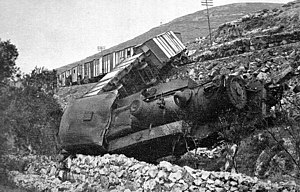
Back التمرد اليهودي في فلسطين الانتدابية Arabic Lucha judía contra los británicos en el mandato de Palestina Spanish 巴勒斯坦犹太人反英暴动 Chinese
| Jewish insurgency in Mandatory Palestine | |||||||
|---|---|---|---|---|---|---|---|
| Part of the intercommunal conflict in Mandatory Palestine and the decolonisation of Asia | |||||||
 Palestine Railway K class 2-8-4T steam locomotive and freight train derailed from the Jaffa and Jerusalem line after being sabotaged by Jewish insurgents in 1946 | |||||||
| |||||||
| Belligerents | |||||||
| Commanders and leaders | |||||||
|
Sir Evelyn Barker Sir Alan Cunningham Harold MacMichael Sir Gordon MacMillan John Vereker, 6th Viscount Gort John Rymer-Jones William Nicol Gray |
Menachem Begin Amichai Paglin Yitzhak Shamir Eitan Livni Nathan Yellin-Mor Moshe Sneh Yisrael Galili | ||||||
| Strength | |||||||
|
British police: 4,000 policemen British Armed Forces: 100,000 troops (peak strength)[3] |
Haganah: 21,000 troops[3]
Lehi: 500 troops | ||||||
| Casualties and losses | |||||||
|
141 killed 475 wounded (August 1945 – August 1947)[4] |
55+ killed 7 executed 2 committed suicide (August 1945 – August 1947)[4] | ||||||
A successful paramilitary campaign, sometimes referred to as the Palestine Emergency, was carried out by Zionist underground groups against British rule in Mandatory Palestine from 1944 to 1948. The tensions between the Zionist underground and the British mandatory authorities rose from 1938 and intensified with the publication of the White Paper of 1939. The Paper outlined new government policies to place further restrictions on Jewish immigration and land purchases, and declared the intention of giving independence to Palestine, with an Arab majority, within ten years. Though World War II brought relative calm, tensions again escalated into an armed struggle towards the end of the war, when it became clear that the Axis powers were close to defeat.
The Haganah, the largest of the Jewish underground militias, which was under the control of the officially recognised Jewish leadership of Palestine, remained cooperative with the British. But in 1944 the Irgun, an offshoot of the Haganah, launched a rebellion against British rule, thus joining Lehi, which had been active against the authorities throughout the war. Both were small, dissident militias of the right-wing Revisionist movement. They attacked police and government targets in response to British immigration restrictions.
The armed conflict escalated during the final phase of World War II, when the Irgun declared a revolt in February 1944, ending the hiatus in operations it had begun in 1940.[5] Starting from the assassination of Baron Moyne by Lehi in 1944, the Haganah actively opposed the Irgun and Lehi, in a period of inter-Jewish fighting known as the Hunting Season, effectively halting the insurrection. However, in autumn 1945, following the end of World War II in both Europe (April–May 1945) and Asia (September 1945), when it became clear that the British would not permit significant Jewish immigration and had no intention of immediately establishing a Jewish state, the Haganah began a period of co-operation with the other two underground organisations. They jointly formed the Jewish Resistance Movement.[6] The Haganah refrained from direct confrontation with British forces, and concentrated its efforts on attacking British immigration control, while Irgun and Lehi attacked military and police targets.[6] The Resistance Movement dissolved amidst recriminations in July 1946, following the King David Hotel bombing. The Irgun and Lehi started acting independently, while the main underground militia, Haganah, continued acting mainly in supporting Jewish immigration.[6] The Haganah again briefly worked to suppress Irgun and Lehi operations, due to the presence of a United Nations investigative committee in Palestine. After the UN Partition Plan resolution was passed on 29 November 1947, the civil war between Palestinian Jews and Arabs eclipsed the previous tensions of both with the British. However, British and Zionist forces continued to clash throughout the period of the civil war up to the termination of the British Mandate for Palestine and the Israeli Declaration of Independence on 14 May 1948.
Within the United Kingdom there were deep divisions over Palestine policy. Dozens of British soldiers, Jewish militants, and civilians died during the campaigns of insurgency. The conflict led to heightened antisemitism in the United Kingdom. In August 1947, after the hanging of two abducted British sergeants, there was widespread anti-Jewish rioting across the United Kingdom.[7] The conflict caused tensions in the United Kingdom–United States relations.
- ^ Charters, David A. The British Army and Jewish Insurgency in Palestine, 1945–47. Springer, 1989, p. X
- ^ a b Hoffman, Bruce. Inside Terrorism. Columbia University Press, New York, pp. 49–51
- ^ a b Paul, Christopher, et al. Paths to Victory: Detailed Insurgency Case Studies, pp. 1–14. Rand National Defense Research Inst Santa Monica CA, 2013.
- ^ a b Hoffman, Bruce (2015-03-02). "Why Terrorism Works". The Chronicle of Higher Education. ISSN 0009-5982. Archived from the original on 5 March 2015. Retrieved 2020-03-12.
The butcher's bill was remarkably modest compared with the horrific standards of terrorism today. Between August 1945 and August 1947, a total of 141 British soldiers and police officers and 40 terrorists died, including those executed or who committed suicide while awaiting execution. Civilian fatalities during the same period were also remarkably low. Fewer than 100 Arab and Jewish noncombatants perished as a result of terrorism between August 1945 and August 1947, and just over 400 were injured.
- ^ Benjamin Grob-Fitzgibbon. Imperial Endgame: Britain's Dirty Wars and the End of Empire. p. 12. [1][permanent dead link]
- ^ a b c French, David (2011). The British Way in Counter-Insurgency, 1945–1967. Oxford University Press. p. 48. ISBN 978-0-19-161859-8. Retrieved 8 March 2021.
- ^ Jewish Chronicle 8/8/47 and 22/8/47, both p. 1. See also Bagon, Paul (2003). "The Impact of the Jewish Underground upon Anglo Jewry: 1945–1947". St Antony's College, University of Oxford M-Phil thesis (mainly the conclusion) Retrieved on 2008-10-25.
© MMXXIII Rich X Search. We shall prevail. All rights reserved. Rich X Search